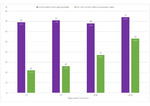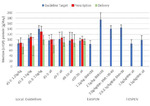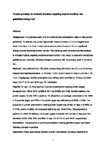Protein provision in critically ill adults requiring enteral feeding
| dc.contributor.author | Mitchell, A | |
| dc.contributor.author | Clemente, R | |
| dc.contributor.author | Downer, C | |
| dc.contributor.author | Greer, F | |
| dc.contributor.author | Allan, K | |
| dc.contributor.author | Collinson, Avril | |
| dc.contributor.author | Taylor, S | |
| dc.date.accessioned | 2023-01-24T12:40:27Z | |
| dc.date.available | 2023-01-24T12:40:27Z | |
| dc.date.issued | 2018-09 | |
| dc.identifier.issn | 0261-5614 | |
| dc.identifier.uri | http://hdl.handle.net/10026.1/20197 | |
| dc.description.abstract |
Background: In a previous audit, 81% of enteral protein prescriptions failed to meet protein guidelines. To address this, a very high protein enteral formula and protein supplements were introduced, and protein prescriptions were adjusted to account for non-nutritional energy sources displacing enteral formula. This follow-up audit compared protein provision in critically ill adults requiring exclusive enteral nutrition (EN), firstly, to local and international guidelines and, secondly, following changes to practice, with the previous audit in the same ICU. Methods: Data collected from 106 adults consecutively admitted to the ICU of a UK tertiary hospital and requiring exclusive EN ≥3 days. Protein targets based on local guidelines (1.25, 1.5 or 2.0g/kg/day), nutrition prescription and delivery were recorded for 24-hours between days 1-3, 5-7, 8-10, and 18-20 post-ICU admission. Results: On day 1-3, the proportion of protein prescriptions meeting protein targets increased from 19% in 2015, to 69% in 2017 (p<0.0005, phi=0.50). Nutrition delivery met protein targets for only 22% of patients. For all patients, on average, prescriptions met 103% of the protein target, and 79% of the protein target was delivered (p<0.0005, r=0.53). The proportion of protein prescriptions meeting protein targets was similar for days 1-3 (69%), 5-7 (71%), and 8-10 (68%), but increased slightly by day 18-20 (74%). The proportion of patients for which EN delivery met protein targets increased with number of days post-ICU admission (22%, 26%, 37%, and 53% for day 1-3, 5-7, 8-10, and 18-20, respectively). Conclusion: The proportion of protein prescriptions meeting guideline targets was higher following changes to practice. | |
| dc.format.extent | S48-S48 | |
| dc.language | en | |
| dc.language.iso | en | |
| dc.publisher | Elsevier BV | |
| dc.title | Protein provision in critically ill adults requiring enteral feeding | |
| dc.type | journal-article | |
| plymouth.issue | Supplement 1 | |
| plymouth.volume | 37 | |
| plymouth.publication-status | Published | |
| plymouth.journal | Clinical Nutrition | |
| dc.identifier.doi | 10.1016/j.clnu.2018.06.1217 | |
| plymouth.organisational-group | /Plymouth | |
| plymouth.organisational-group | /Plymouth/Faculty of Health | |
| plymouth.organisational-group | /Plymouth/Faculty of Health/School of Health Professions | |
| plymouth.organisational-group | /Plymouth/REF 2021 Researchers by UoA | |
| plymouth.organisational-group | /Plymouth/REF 2021 Researchers by UoA/UoA03 Allied Health Professions, Dentistry, Nursing and Pharmacy | |
| plymouth.organisational-group | /Plymouth/Research Groups | |
| plymouth.organisational-group | /Plymouth/Research Groups/Institute of Health and Community | |
| plymouth.organisational-group | /Plymouth/Research Groups/Plymouth Institute of Health and Care Research (PIHR) | |
| plymouth.organisational-group | /Plymouth/Users by role | |
| plymouth.organisational-group | /Plymouth/Users by role/Academics | |
| dcterms.dateAccepted | 2018-09-29 | |
| dc.rights.embargodate | 2023-1-26 | |
| rioxxterms.versionofrecord | 10.1016/j.clnu.2018.06.1217 | |
| rioxxterms.licenseref.uri | http://www.rioxx.net/licenses/all-rights-reserved | |
| rioxxterms.type | Journal Article/Review |




